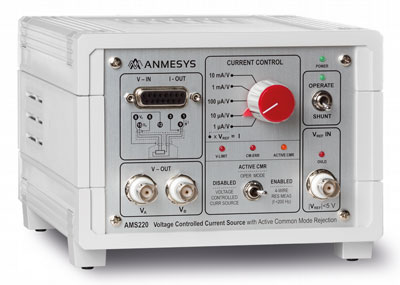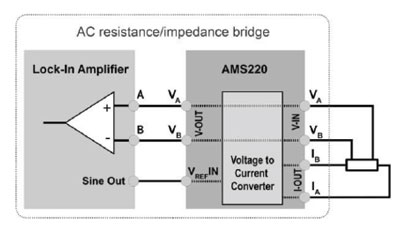New current source for measurements of very small resistances

When measuring very small resistances, a common effect is the so-called common mode rejection (CMR). The error that occurs from this effect can heavily distort the measured voltage. Fig. 1a shows this distortion with a determined resistance of 100 mΩ. A common current source provides a current of 10 mA and the voltage we measured is an incorrect 3 µV instead of 1 µV. The reason for this is an assumed but realistic value resistance of 20 Ω between the earth, sample and current source.

Fig. 1a: Four-wire resistance measurement with common current source connected to ground. The indicated measured voltage value deviates considerably from the voltage actually applied to the sample.
Fig. 1b: Four-wire resistance measurement with current source that actively suppresses CMR. The indicated measured voltage value corresponds to the actual voltage applied to the sample.
Our new partner Anmesys has developed a special current source that can suppress the CMR effect: AMS220. It comes with a lock-in amplifier and can also be used as regular current source.
Fig. 1 shows the setup with AMS220: The CMR effect is suppressed and as a result, the correct voltage of 1 µV is detected. Contrary to regular sources, the patented AMS220 is free-floating.
The current is directly controlled by input voltage. Fig. 2 shows a typical setup for an AC resistance measurement with lock-in amplifier and AMS220.

Fig. 2
The common mode rejection effect may occur
- with samples with small resistances (and high contact resistances, where applicable)
- during AC-resistance measurements, for example with lock-in technique
- during resistance measurements in cryogenics, when the sample resistance decreases with low temperatures
- with thermometry
| Frequency range | DC – 200 Hz (“active CMR” switched on) DC – 20 kHz (“active CMR” switched off) |
| Input control voltage range | 3.6 VRMS / ±5 V (DC) |
| Current-voltage relationship 1 µA/V to 10 mA/V | Max. AC current (RMS) 36 mA |
| Max. DC current | ±50 mA |



